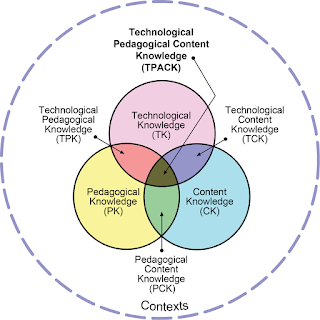 TPACK overview
TPACK overview
- Technology Pedagogy and Content Knowledge
CPK - The starting point
PK: Shulman, 1987
- Content Pedagogy Knowledge
- Shulman (pre ’87) claimed that teachers' subject knowledge and pedagogy were being treated as mutually exclusive domains.
- Consequence: a focus on either subject matter or pedagogy dominated education.
- Shulman proposed that effective teaching existed in the overlap of the 2 dichotomies.
PCK: explanation
PCK is the intersection and interaction of pedagogy and content knowledge.
Essential Knowledge & effective teaching
PCK includes
- Essential knowledge content-based curricula
- Subject-specific concepts, theories & practices
- Assessment and reporting processes
- Instructional planning
- Student's prior knowledge
- Theories of learning - cognitive, social & developmental
- Alternative teaching strategies
PCK: Teacher education programs
“Most teacher education programs in Australia have been designed by taking into account PCK.”
Teacher education programs are now considering the role of technology in learning - TPACK
DER: Teacher ICT Capabilities & Pedagogy
Digital Educational Revolution Australia
Teachers make innovative & effective use of ICT in pedagogy
DER - Implementation
Leadership
- Plan and lead change
- Deliver digital learning to students in all areas
Infrastructure
- Learning management systems (Moodle)
- ePortfolios (Mahara)
Learning Resources
- Digital education resources (Scootle)
Teacher Capability
- Harness the resources of the digital revolution
- Integration of ICT to support changed pedagogies (ELITE AMPeL)
Warning: Technology without Pedagogy
Technology cannot be the driving force
- Avoid the Mirror Image Syndrome
Avoid ICT replacements without due consideration of the purpose.
- Think before a lesson becomes a PowerPoint with notes
- Think before a class discussion becomes a forum
- Think before a resource becomes a webpage with hyperlinks
Technology without pedagogical and content application will result in a reductive learning environment.
TPACK: Integrating Technology
TPACK
- Integrates Technology with Pedagogy & Content Knowledge
Advice:
- Increased technology for technology sake does not lead to increased student learning.
- The effectiveness of technology is dependant on teaching practices.
- How you integrate content and pedagogy with technology matters as much as integrating technology with pedagogy and technology.
- If teachers see content, technology, and pedagogy as separate domains - technology will always be just an ineffective add on.
TPACK: Overview
TPACK is an understanding of interactions within the following domains
- Technology
- Pedagogy
- Content
To effectively understand TPACK teachers need to understand how
Technology Pedagogy and Content works in;
- Isolation
- Together
- and in Context
TPACK example: Story retelling
- Activity: Retelling a story
- Setup: Class is divided into groups of 2 - Story is broken up into sections to accommodate the groups
- Learning Objectives: Reading Comprehension Skills & Oral Speaking Skills
- Learning Process: Students will read a text, retelling the story using Media Editor and share the retold story
TPACK: Questions
Questions to ask yourself
- Which of the domains do you find easiest to work within?
- Which overlapping domains do you find most difficult to work with?
- How will you plan your learning environment to include all domains and overlaps?





Comments
Post a Comment